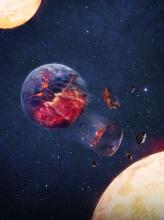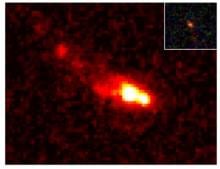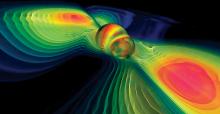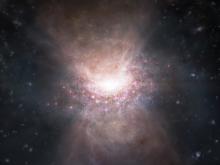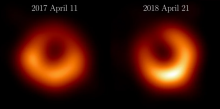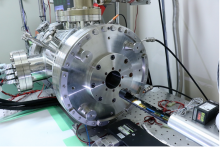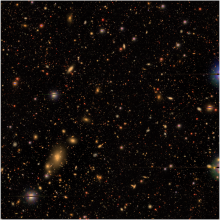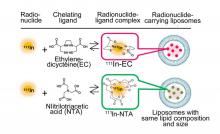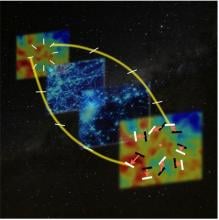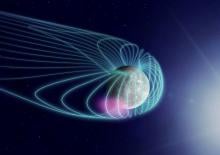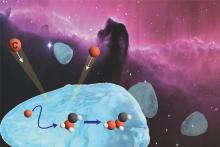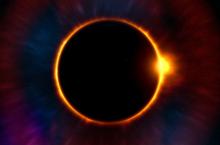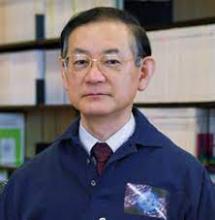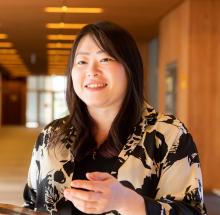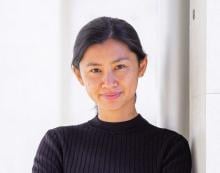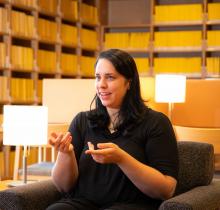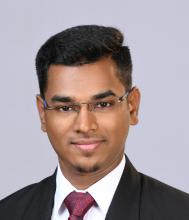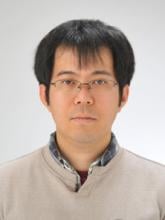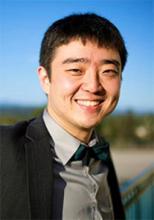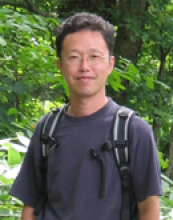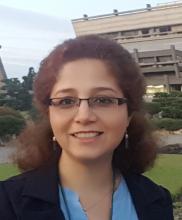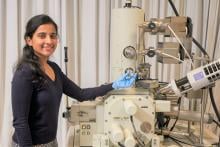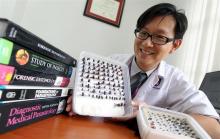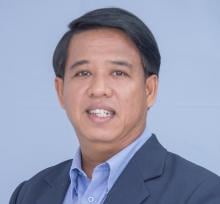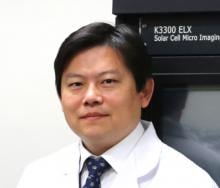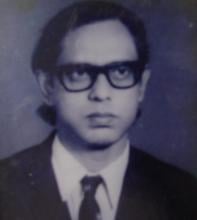Space
News
19 Apr 2024
Asia Research News monitors the latest research news in Asia. Some highlights that caught our attention this week are the discovery that baby stars “sneeze”, how to increase panda reproduction and detect fiddler crab signals, and how being slightly overweight in our older years can be beneficial.
21 Mar 2024
At least one in a dozen stars show evidence of planetary ingestion according to a paper published in Nature today.
14 Mar 2024
Ancient Mars biomolecules, Gargling away bad bacteria, Molecule glasses magnify life-chemical observations, Cholesterol and cancer link, Quantum electronics leap, Plus our updated Experts for Media: Women list & Asia Research News 2024 is here. Read all in the latest Editor's Choice.
13 Mar 2024
An international research team have made unprecedentedly detailed observations of the earliest merger of galaxies ever witnessed. They suggest stars developed much faster and more efficiently than we thought. They used the James Webb Space Telescope (JWST) to observe the massive object as it was 510 million years after the Big Bang – i.e. around 13 billion years ago.
07 Mar 2024
In celebration of International Women's Day, we are putting the spotlight on women experts from various fields who are open to speaking with international media about their research and advocacies.
28 Feb 2024
Organic materials discovered on Mars may have originated from atmospheric formaldehyde, according to new research, marking a step forward in our understanding of the possibility of past life on the Red Planet.
27 Feb 2024
Jun’ichi Yokoyama once amused his professors by proposing a far-fetched idea of using neutrinos and gravitational waves to observe the Universe. Decades later, he was proven right and contends young scientists should be nurtured to believe in themselves.
23 Feb 2024
Asia Research News monitors the latest research news in Asia. Some highlights that caught our attention this week are a biosensor to detect meat freshness, a cute and spooky sea creature, and how even shorter amounts of exercise can lead to benefits.
13 Feb 2024
Researchers including Kavli IPMU have used equipment originally intended for astronomy observation to capture transformations in the nuclear structure of atomic nuclei, reports a study in Scientific Reports.
01 Feb 2024
Theoretical predictions have been confirmed with the discovery of an outflow of molecular gas from a quasar when the Universe was less than a billion years old.
23 Jan 2024
The Hayabusa2 mission that collected samples from the asteroid Ryugu has provided a treasure trove of insights into our solar system. After analyzing samples further, a team of researchers have unearthed evidence that cometary organic matter was transported from space to the near-Earth region.
19 Jan 2024
A recent paper published in the journal Astronomy & Astrophysics presents new images from the 2018 data that reveal a familiar ring the same size as observed in 2017. This bright ring surrounds a deep central depression, “the shadow of the black hole,” as predicted by general relativity. Excitingly, the peak brightness of the ring has shifted by about 30º counter clockwise compared to its position in 2017, which is consistent with our theoretical understanding of the variability of the turbulent material around black holes.
25 Dec 2023
Kavli IPMU researchers are part of a team that has shown it is possible to image small animal tissue clearly to several hundred micrometers using multi-probe imaging.
21 Dec 2023
Kavi IPMU researchers have analyzed more than one million galaxies to explore primordial fluctuations that seeded the formation of the structure of the entire universe.
15 Dec 2023
Asia Research News monitors the latest research news in Asia. Some highlights that caught our attention this week are a motorized tentacle you can wear on your finger, a star that came from a long way away and a long time ago, and a new champion in the competition for the fastest robo-quadruped.
13 Dec 2023
"Amaterasu" particle: a new cosmic mystery, Geckos inspire robotic device, Targeting cancer while protecting healthy cells, Honey, I shrunk the bear, Two species lost to science spotted again. Plus New Science Communication Resources. Read all in the latest Editor's Choice.
11 Dec 2023
Asteroids offer valuable windows into the early solar system, given that they are remnants of planetary embryos that failed to form into planets. A recent analysis of samples from Ryugu offered insights into the composition of water- and carbon-rich small bodies in the solar system.
21 Nov 2023
Researchers develop new method suppressing the distribution of drugs to healthy tissues, but also to rapidly removes the drugs once distributed in the body, which could improve the accuracy of imaging diagnosis of difficult cancers, reduce toxicity to healthy tissues, and furthermore improve the effectiveness of treatment.
17 Nov 2023
Asia Research News monitors the latest research news in Asia. Some highlights that caught our attention this week are sea cucumbers that glow in the dark, a needle that softens at body temperature, and the real size of our sun.
16 Nov 2023
… all while discovering how the Universe evolved, how galaxies form and where the elements come from.
06 Nov 2023
Almost every large galaxy has a supermassive black hole at its center. An international research team has recently observed the Circinus galaxy, which is one of the closest galaxies to the Milky Way, with high enough resolution to gain further insights into the gas flows to and from the black hole at its galactic nucleus.
02 Nov 2023
Asia Research News monitors the latest research news in Asia. Some highlights that caught our attention this week are mouse embryos grown on the International Space Station, a super-efficient micro engine, and how a virus can help deaf children hear.
02 Nov 2023
Future missions will be able to find signatures of violating the parity-symmetry in the cosmic microwave background polarization more accurately after a pair of researchers has managed to take into account the gravitational lensing effect, reports a new study in Physical Review D, selected as an Editors' Suggestion.
13 Oct 2023
Asia Research News monitors the latest research news in Asia. Some highlights that caught our attention this week are radiation blasts that come from outer space, a new way of seeing the Earth’s core, and a prosthetic socket that fills in the gaps.
12 Oct 2023
Osaka Metropolitan University scientists, in cooperation with researchers from the National Astronomical Observatory of Japan, have captured cosmic-ray extensive air showers with unprecedented precision using the prime-focus wide field camera mounted on the Subaru Telescope, situated atop Mauna Kea in Hawaii. Analyzing approximately 17,000 images captured between 2014 and 2020, they pinpointed 13 images containing extensive air showers, with a number of particle tracks far exceeding the usual count.
05 Oct 2023
Hunting for supermassive black holes, Coastal survival at risk, Calcium and dead cell clean-up, Two naps are better than one & Pineapple leaf prosthetics. Read all in the latest Editor's Choice.
29 Sep 2023
Observations during two flybys by the Mio spacecraft as part of the BepiColombo International Mercury Exploration Project have revealed that chorus waves occur quite locally in the dawn sector of Mercury. Mercury's magnetic field is about 1% of that of Earth, and it was unclear whether chorus waves would be generated like on Earth. The present study reveals that the chorus waves are the driving source of Mercury’s X-ray auroras, whose mechanism was not understood.
14 Sep 2023
Lab-based studies reveal how carbon atoms diffuse on the surface of interstellar ice grains to form complex organic compounds, crucial to reveal the chemical complexity in the universe.
11 Sep 2023
Elusive fundamental particles called neutrinos are predicted to interact unexpectedly with photons under extreme conditions.
08 Sep 2023
Asia Research News monitors the latest research news in Asia. Some highlights that caught our attention this week are a new species of fish that was spotted being sold at local markets, how humans almost went extinct, and an Earth-like planet that may be lurking in our solar system.
Events

24 Nov 2021
24 November 2021 | 1:00 – 2:00 PM via Zoom
25 Aug 2021
The development of the ASTI Virtual Reality Simulation (ASTI VRS) App – an incorporation of the three Ground Receiving Stations and satellites, all in an android app – is one of DOST-ASTI's attempts to bring the space closer to the Filipino people. The application, available in Google Playstore free of charge, features a comprehensive computer-generated simulation of the ASTI-GRS in Metro Manila, the Davao GRS in Davao City and the Iloilo GRS in Iloilo that users can explore. The application also includes a satellite showcase where users can learn about the Filipino-made Diwata and Maya satellites as well as the different commercial satellites the PEDRO Center subscribes to.
09 Sep 2021
Earth-Life Science Institute (ELSI) will launch a new Master-PhD course on origin-of-life science and astrobiology at Tokyo Institute of Technology. The five-year ELSI course is open for domestic and international students who wish to tackle fundamental questions in natural science such as the origin and evolution of living planets. ELSI will provide financial support (as salary of a research assistant) for all the students, except for ones who are going to be supported by JSPS DC fellowships (Japan) or equivalent fellowships.
The Khwarizmi International Award (KIA) acknowledges the efforts made by researchers, innovators and inventors from across the globe and to appreciate their high quality research work and contributions to different fields of science and technology.
Researchers
Angel Investor and a Vision-driven entrepreneur/executive with career-long record of business growth and innovation.
Kavli Institute for the Physics and Mathematics of the Universe (Kavli IPMU)
Ken’ichi Nomoto is a visiting senior scientist at Kavli IPMU and Professor Emeritus at The University of Tokyo. He is one of the best experts in the world in astronomy and astrophysics, particularly on stellar evolution and supernovae. He was awarded the Order of the Sacred Treasure by the Japanese government in 2020.
Kavli Institute for the Physics and Mathematics of the Universe (Kavli IPMU)
Miho Katsuragawa is a specially appointed project researcher at Kavli IPMU. Her areas of expertise include experimental physics, detector/instrument development, medical application of gamma-ray imaging, and high energy astrophysics.
Kavli Institute for the Physics and Mathematics of the Universe (Kavli IPMU)
Jia Liu is the Director of the Center for Data-Driven Discovery and associate professor at CMB Group at Kavli IPMU. Her research integrates data science techniques in the study of large-scale structures of the universe (dark matter, halos, filaments, voids).
Kavli Institute for the Physics and Mathematics of the Universe (Kavli IPMU)
Elisa Ferreira is Assistant Professor at the Kavli IPMU and at the Institute of Physics of the University of São Paulo. Her research deals with the interface between cosmology, astrophysics, and high energy physics, focusing mostly on dark energy and dark matter.
City University of Hong Kong (CityU)
Prof. Yang Yong's primary research interest is in the development and mechanical behavior of advanced structural materials, such as metallic glasses and high entropy alloys. His recent research also extends to mechanics of flexible electronics and hydrogels.
Nanyang Technological University
Dr. Arun works as a Research Assistant Professor (RAP) at the Rolls-Royce@NTU Corporate Lab, Nanyang Technological University, Singapore. Through cutting-edge technology development and commercialization, he contributes to the Singapore 2030 Advanced Manufacturing Hub (AMH) and Jurong Innovation District (JID) initiatives. He also acts as an IPT-Lead of the Manufacturing Technologies programme at Rolls-Royce@NTU and leads several projects, researchers, and students.
Universiti Malaysia Sabah
Dr. Connie Cassy Ompok is an early childhood education expert and a Senior Lecturer at the Faculty of Psychology and Education, Universiti Malaysia Sabah. She Started her career in Early Childhood Education as a preschool teacher (2004-2007), a lecturer in early childhood education at the Malaysian Institute of Teacher Education (2008-2016) before serving as a Senior Lecturer in Early Childhood Education at UMS (2016 until now).
Hitoshi Gomi is an Earth scientist at Earth-Life Science Institute (ELSI) based at the Tokyo Institute of Technology, Japan.
Earth-Life Science Institute (ELSI), Tokyo Institute of Technology
Tony Z. Jia is a researcher at Japan’s Earth-Life Science Institute (ELSI), based at the Tokyo Institute of Technology. His research focuses on astrobiology, prebiotic chemistry, and origins of life.
Hokkaido University
Takeshi Horinouchi is a professor at the Faculty of Environmental Earth Science, Hokkaido University, Japan.
Since September 2023, I am a researcher at Mainz University, Germany. Before that, I was an Assistant Professor of the Physics Department at the Institute for Advanced Studies in Basic Science (IASBS), Zanjan, Iran since Dec. 2015. However, in September 2012, I resigned from my faculty position in support of the "Woman, Life, Freedom" protest in Iran and now I am an exiled scholar. I have been a Junior Associate of the International Center of Theoretical Physics (ICTP), Trieste, Italy since January 2017 and a TWAS Young Affiliate member since 2018. I was a visiting researcher at ICTP-SAIFR, São Paulo, Brazil (June - Nov. 2015) under the TWAS fellowship, and also a Post-Doctoral fellow of the School of Physics in the Institute for Research in Fundamental Sciences (IPM) Tehran, Iran (Oct. 2012 - May 2015). I finished my Ph.D. in the Physics Department of Rheinische Friedrich-Wilhelms-Universität Bonn, Germany in Aug. 2012. I did also a one-year Postgraduate Diploma Programme of ICTP (2007-2008) in High Energy Physics.
Nanyang Technological University
Dr. Sravya Tekumalla is currently a Principal Investigator in Nanyang Technological University, Singapore, where she works as a Presidential Postdoctoral Fellow. In addition, she also leads a small team of staff and students working in the domain of metal additive manufacturing (commonly known as 3D printing).
Dr Anisa Qamar is a professor in Physics in the Department of Physics, University of Peshawar, Pakistan. She is also the President of Pakistan Physical Society.
Universiti Teknologi MARA (UiTM)
Dr Heo is currently a senior lecturer at the Department of Microbiology and Parasitology, Faculty of Medicine, Universiti Teknologi MARA, Malaysia.
I am a senior lecturer in the School of the Built Environment. Prior to this I was a post-doctoral researcher at the Cambridge Centre for Housing and Planning Research, University of Cambridge (2001-2004) and a researcher at the Korea Research Institute for Human Settlement (1986-1994). I hold a BSc in Management Studies and MBA from the Univeristy of Ewha, Seoul, Korea and gained my PhD from London School of Economics and Political Science in 2000.
Tohoku University
Department of Earth Science, Graduate School of Science, Tohoku University, Japan.
Puvadol Doydee is an Assistant Professor in the Faculty of Natural Resources and Agro-Industry at Kasetsart University Chalermphrakiat Sakon Nakhon Province Campus, Sakon Nakhon Province, Thailand.
Daegu Gyeongbuk Institute of Science and Technology (DGIST)
Prof. SU-IL IN has been working at DGIST (Daegu Gyeongbuk Institute of Science & Technology) since 2012. He served as Dean of International and External Affairs 2016 ~ 2017. He received his Ph.D. in Chemistry from University of Cambridge in 2008. Subsequently he was a postdoctoral researcher at Technical University of Denmark by 2010. Then he joined the Pennsylvania State University as a postdoctoral researcher in the Department of Chemistry before joining DGIST. Professor In’s current researches include synthesis and analysis of functional nano (bio)-materials for environmentally friendly renewable energy such as photovoltaic, heterogeneous catalysis and biocatalysts. (https://insuil.dgist.ac.kr/)
Giants in history
Chinese electron microscopy specialist Li Fanghua (6 January 1932 – 24 January 2020) facilitated the high-resolution imaging of crystal structures by eliminating interference.
Haisako Koyama (1916 – 1997) was a Japanese solar observer whose dedication to recording sunspots – cooler parts of the sun’s surface that appear dark – produced a sunspot record of historic importance.
Angelita Castro Kelly (1942-2015) was the first female Mission Operations Manager (MOM) of NASA. She spearheaded and supervised the Earth Observing System missions during its developmental stage.
Malaysia’s first astrophysicist, Mazlan binti Othman (born 11 December 1951) was instrumental in launching the country’s first microsatellite, and in sending Malaysia’s first astronaut, Sheikh Muszaphar Shukor, into space.
Meghnad Saha (6 October 1893 – 16 February 1956) was an Indian astrophysicist best known for formulating the Saha ionization equation which describes the chemical and physical properties of stars.
Subrahmanyan Chandrasekhar (19 October 1910 – 21 August 1995) was an Indian astrophysicist who studied the structure and evolution of stars.
Abdus Suttar Khan (c. 1941 – 31 January 2008) was a Bangladeshi engineer who spent a significant part of his career conducting aerospace research with NASA, United Technology and Alstom.
Bibha Chowdhuri (1913 – 2 June 1991) was an Indian physicist who researched on particle physics and cosmic rays. In 1936, she was the only female to complete a M.Sc. degree at the University of Calcutta.



